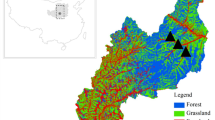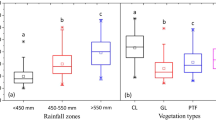Abstract
Land use patterns (LUPs) are the form in which various land use types are combined spatially, evidently impacting soil water. However, the influence mechanism by which LUPs form remains unclear. In this study, the soil water content (SWC) in the 0–160-cm soil depth was observed in shrubland (SL), mature forestland (MF), grassland (GL) and young forestland (YF) sites on four slopes with different LUPs in the Yangjuangou catchment of the Chinese Loess Plateau. The SWC in SL-YF-SL (13.28%) was significantly greater than that in YF-MF (9.93%), MF-GL-YF (10.38%) and SL-MF (10.83%) and was temporally stable during the study period. The spatial distribution of SWC along the slope differed among the four LUPs. Vegetation characteristics and soil texture mainly determined the spatial variations in SWC in the shallow soil layers (0–40 cm), while topographic factors were the determinants in the deep soil layers (60–160 cm) as well as in the entire soil profile (0–160 cm). The significance of SWC differences among the various land use patterns increased with decreasing precipitation during the growing seasons. YF-MF (77.8 mm) and SL-YF-GL (73.9 mm) required more rainwater than SL-MF (68.2 mm) and MF-GL-MF (67.5 mm) to compensate for the loss of soil water on the monthly scale during the rainy season. Therefore, vegetation restoration should consider land use patterns on hillslopes for soil water conservation.
Similar content being viewed by others
References
An W, Li Z, Wang S et al., 2017. Exploring the effects of the “Grain for Green” program on the differences in soil water in the semi-arid Loess Plateau of China. Ecological Engineering, 107: 144–151.
Asbjornsen H, Goldsmith G R, Alvarado-Barrientos M S et al., 2011. Ecohydrological advances and applications in plant-water relations research: A review. Journal of Plant Ecology, 4(1/2): 3–22.
Cao Z, Li Y, Liu Z et al., 2019. Quantifying the vertical distribution pattern of land-use conversion in the loess hilly region of northern Shaanxi Province 1995–2015. Journal of Geographical Sciences, 29(5): 730–748.
Caravaca F, Masciandaro G, Ceccanti B, 2002. Land use in relation to soil chemical and biochemical properties in a semiarid Mediterranean environment. Soil & Tillage Research, 68(1): 23–30.
Chen W, Li Z, Jiao L et al., 2020. Response of soil moisture to rainfall event in black locust plantations at different stages of restoration in hilly-gully area of the Loess Plateau, China. Chinese Geographical Science, 30(3): 427–445.
Cheng R R, Chen Q W, Zhang J G et al., 2020. Soil moisture variations in response to precipitation in different vegetation types: A multi-year study in the loess hilly region in China. Ecohydrology, 13(3): e2196.
Dymond S F, Bradford J B, Bolstad P V et al., 2017. Topographic, edaphic, and vegetative controls on plant-available water. Ecohydrology, 10(8): e1897.
Earles J M, Stevens J T, Sperling O et al., 2018. Extreme mid-winter drought weakens tree hydraulic-carbohydrate systems and slows growth. New Phytologist, 219(1): 89–97.
Fang X, Zhao W, Wang L et al., 2016. Variations of deep soil moisture under different vegetation types and influencing factors in a watershed of the Loess Plateau, China. Hydrology and Earth System Sciences, 20(8): 3309–3323.
Feldman A F, Short G D J, Konings A G et al., 2018. Moisture pulse-reserve in the soil-plant continuum observed across biomes. Nature Plants, 4(12): 1026–1033.
Feng T, Wei W, Chen L et al., 2018. Effects of land preparation and plantings of vegetation on soil moisture in a hilly loess catchment in China. Land Degradation & Development, 29(5): 1427–1441.
Feng X, Fu B, Piao S et al., 2016. Revegetation in China’s Loess Plateau is approaching sustainable water resource limits. Nature Climate Change, 6(11): 1019–1022.
Ferrante D, Oliva G E, Fernández R J, 2014. Soil water dynamics, root systems, and plant responses in a semiarid grassland of Southern Patagonia. Journal of Arid Environments, 104: 52–58.
Fu B, Chen L, Ma K et al., 2000. The relationships between land use and soil conditions in the hilly area of the loess plateau in northern Shaanxi, China. Catena, 39(1): 69–78.
Fu B, Wang J, Chen L et al., 2003. The effects of land use on soil moisture variation in the Danangou catchment of the Loess Plateau, China. Catena, 54(1): 197–213.
Fu B, Wang S, Liu Y et al., 2017. Hydrogeomorphic ecosystem responses to natural and anthropogenic changes in the Loess Plateau of China. Annual Review of Earth and Planetary Sciences, 45(1): 223–243.
Fu B, Wang Y, Lu Y et al., 2009. The effects of land-use combinations on soil erosion: A case study in the Loess Plateau of China. Progress in Physical Geography, 33(6): 793–804.
Gao G, Tuo D, Han X et al., 2020. Effects of land-use patterns on soil carbon and nitrogen variations along revegetated hillslopes in the Chinese Loess Plateau. Science of the Total Environment, 746: 141156.
Gwak Y, Kim S. 2016. Factors affecting soil moisture spatial variability for a humid forest hillslope. Hydrological Processes, 31: 431–445.
Jia X, Shao M A, Zhu Y et al., 2017. Soil moisture decline due to afforestation across the Loess Plateau, China. Journal of Hydrology, 546: 113–122.
Jian S, Zhao C, Fang S et al., 2015. Effects of different vegetation restoration on soil water storage and water balance in the Chinese Loess Plateau. Agricultural and Forest Meteorology, 206: 85–96.
Jiao L, Lu N, Fang W et al., 2019. Determining the independent impact of soil water on forest transpiration: A case study of a black locust plantation in the Loess Plateau, China. Journal of Hydrology, 572: 671–681.
Jiao L, Lu N, Sun G et al., 2016. Biophysical controls on canopy transpiration in a black locust (Robinia pseudoacacia) plantation on the semi-arid Loess Plateau, China. Ecohydrology, 9(6): 1068–1081.
Legates D R, Mahmood R, Levia D F et al., 2010. Soil moisture: A central and unifying theme in physical geography. Progress in Physical Geography: Earth and Environment, 35(1): 65–86.
Leitinger G, Ruggenthaler R, Hammerle A et al., 2015. Impact of droughts on water provision in managed alpine grasslands in two climatically different regions of the Alps. Ecohydrology, 8(8): 1600–1613.
Liu Y, Fu B, Lu Y et al., 2012. Hydrological responses and soil erosion potential of abandoned cropland in the Loess Plateau, China. Geomorphology, 138(1): 404–414.
Llorens P, Domingo F, 2007. Rainfall partitioning by vegetation under Mediterranean conditions. A review of studies in Europe. Journal of Hydrology, 335(1): 37–54.
Magliano P N, Whitworth-Hulse J I, Florio E L et al., 2019. Interception loss, throughfall and stemflow by Larrea divaricata: The role of rainfall characteristics and plant morphological attributes. Ecological Research, 34(6): 753–764.
Penna D, Brocca L, Borga M et al., 2013. Soil moisture temporal stability at different depths on two alpine hillslopes during wet and dry periods. Journal of Hydrology, 477: 55–71.
Recha J W, Mati B M, Nyasimi M et al., 2016. Changing rainfall patterns and farmers’ adaptation through soil water management practices in semi-arid eastern Kenya. Arid Soil Research & Rehabilitation, 30(3): 229–238.
She D L, Shao M A, Timm L C et al., 2010. Impacts of land-use pattern on soil water-content variability on the Loess Plateau of China. Acta Agriculturae Scandinavica Section B: Soil and Plant Science, 60(4): 369–380.
Shi P, Zhang Y, Li Z et al., 2017. Influence of land use and land cover patterns on seasonal water quality at multi-spatial scales. Catena, 151: 182–190.
Singh G, Panda R K, Mohanty B P, 2019. Spatiotemporal analysis of soil moisture and optimal sampling design for regional-scale soil moisture estimation in a tropical watershed of India. Water Resources Research, 55: 2057–2078.
Wang C, Fu B, Zhang L et al., 2019. Soil moisture—plant interactions: An ecohydrological review. Journal of Soils and Sediments, 19: 1–9.
Wang J, Fu B, Qiu Y et al., 2003. The effects of land use and its patterns on soil properties in a small catchment of the Loess Plateau. Journal of Environmental Sciences, 15(02): 263–266.
Wang S, Fu B, Gao G et al., 2015. Linking the soil moisture distribution pattern to dynamic processes along slope transects in the Loess Plateau, China. Environmental Monitoring & Assessment, 187(12): 778.
Wang S, Fu B, Gao G et al., 2013. Responses of soil moisture in different land cover types to rainfall events in a re-vegetation catchment area of the Loess Plateau, China. Catena, 101: 122–128.
Wang S, Fu B, Gao G et al., 2012. Soil moisture and evapotranspiration of different land cover types in the Loess Plateau, China. Hydrology and Earth System Sciences, 16(8): 2883–2892.
Wang Y, Shao M A, Zhu Y et al., 2011. Impacts of land use and plant characteristics on dried soil layers in different climatic regions on the Loess Plateau of China. Agricultural and Forest Meteorology, 151(4): 437–448.
Wang Z, Liu B, Zhang Y, 2009. Soil moisture of different vegetation types on the Loess Plateau. Journal of Geographical Sciences, 19(6): 707–718.
Western A W, Zhou S L, Grayson R B et al., 2004. Spatial correlation of soil moisture in small catchments and its relationship to dominant spatial hydrological processes. Journal of Hydrology, 286(1): 113–134.
Yang L, Chen L D, Wei W et al., 2014. Comparison of deep soil moisture in two re-vegetation watersheds in semi-arid regions. Journal of Hydrology, 513: 314–321.
Yang L, Chen L, Wei W, 2015. Effects of vegetation restoration on the spatial distribution of soil moisture at the hillslope scale in semi-arid regions. Catena, 124: 138–146.
Yang L, Zhang H, Chen L, 2018. Identification on threshold and efficiency of rainfall replenishment to soil water in semi-arid loess hilly areas. Science China Earth Sciences, 61: 292–301. (in Chinese)
Yu X, Zhou W, Wang Y et al., 2020. Effects of land use and cultivation time on soil organic and inorganic carbon storage in deep soils. Journal of Geographical Sciences, 30(6): 921–934.
Yu Y, Wei W, Chen L et al., 2017. Land preparation and vegetation type jointly determine soil conditions after long-term land stabilization measures in a typical hilly catchment, Loess Plateau of China. Journal of Soils and Sediments, 17(1): 144–156.
Yu Y, Zhao W, Martinez-Murillo J F et al., 2020. Loess Plateau: From degradation to restoration. Science of the Total Environment, 738: 140206.
Zhang Y, Shangguan Z, 2016. The change of soil water storage in three land use types after 10 years on the Loess Plateau. Catena, 147: 87–95.
Zhao W, Fu B, Meng Q et al., 2004. Effects of land-use pattern change on rainfall-runoff and runoff-sediment relations: A case study in Zichang watershed of the Loess Plateau of China. Journal of Environmental Sciences, 16(3): 436–442.
Zhu Y, Jia X, Shao M A, 2018. Loess thickness variations across the Loess Plateau of China. Surveys in Geophysics, 39(4): 715–727.
Author information
Authors and Affiliations
Corresponding author
Additional information
Foundation: National Key Research and Development Program of China, No.2017YFC0504701, No.2016YFC0501602; Natural Science Basic Research Plan in Shaanxi Province of China, No.2019JQ-767; Doctoral Foundation of Tianjin Normal University, No.52XB1910
Author: Jiao Lei (1985–), PhD, specialized in ecological restoration and ecohydrology.
Rights and permissions
About this article
Cite this article
Jiao, L., Yang, W., Jia, T. et al. Effects of land use patterns on slope soil water in the semiarid Loess Plateau, China. J. Geogr. Sci. 32, 701–716 (2022). https://doi.org/10.1007/s11442-022-1968-7
Received:
Accepted:
Published:
Issue Date:
DOI: https://doi.org/10.1007/s11442-022-1968-7




